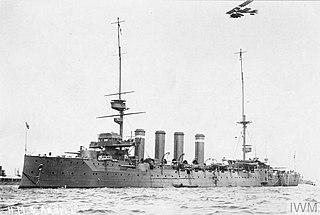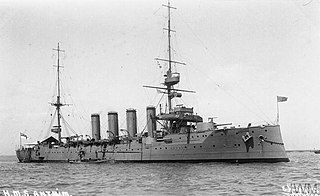
The Battle of the Falkland Islands was a First World War naval action between the British Royal Navy and Imperial German Navy on 8 December 1914 in the South Atlantic. The British, after their defeat at the Battle of Coronel on 1 November, sent a large force to track down and destroy the German cruiser squadron. The battle is commemorated every year on 8 December in the Falkland Islands as a public holiday.

HMS Kent was one of 10 Monmouth-class armoured cruisers built for the Royal Navy in the first decade of the 20th century. She was placed in reserve when completed in 1903, but was recommissioned for the China Station in 1906. She remained there until she returned home in 1913 for a lengthy refit.

HMS Cornwall was one of 10 Monmouth-class armoured cruisers built for the Royal Navy in the first decade of the 20th century. She was assigned to the 2nd Cruiser Squadron of the Channel Fleet on completion in 1903. The ship was refitted in 1907 in preparation for service as a training ship for cadets with the 4th Cruiser Squadron on the North America and West Indies Station beginning in 1908.

HMS Argyll was one of six Devonshire-class armoured cruisers built for the Royal Navy in the first decade of the 20th century. She was assigned to the 1st Cruiser Squadron of the Channel Fleet upon completion and was transferred to the 5th Cruiser Squadron of the Atlantic Fleet in 1909. Two years later, she was detached to escort the royal yacht during King George V's trip to British India. Argyll was assigned to the 3rd Cruiser Squadron of the reserve Second Fleet in 1913.

HMS Monmouth was the name ship of her class of 10 armoured cruisers built for the Royal Navy in the first decade of the 20th century. The ships were also known as the County Cruisers.

HMS Glasgow was one of five ships of the Bristol sub-class of the Town-class light cruisers built for the Royal Navy in the first decade of the 20th century. Completed in 1910, the ship was briefly assigned to the Home Fleet before she was assigned to patrol the coast of South America. Shortly after the start of the First World War in August 1914, Glasgow captured a German merchant ship. She spent the next several months searching for German commerce raiders. The ship was then ordered to join Rear Admiral Christopher Cradock's squadron in their search for the German East Asia Squadron. He found the German squadron on 1 November off the coast of Chile in the Battle of Coronel. They outnumbered Cradock's force and were individually more powerful, sinking Cradock's two armoured cruisers, although Glasgow was only lightly damaged.

HMS Suffolk was one of 10 Monmouth-class armoured cruisers built for the Royal Navy in the first decade of the 20th century. Upon completion she was assigned to the 3rd Cruiser Squadron of the Mediterranean Fleet and was then assigned to the 5th Cruiser Squadron in the Mediterranean in 1909 after a lengthy refit. She returned home for another refit in 1912 and became the flagship of the 4th Cruiser Squadron on the North America and West Indies Station in 1913.

HMS Hogue was a Cressy-class armoured cruiser built for the Royal Navy around 1900. Upon completion she was assigned to the Channel Fleet and the China Station. In 1906 she became a training ship for the North America and West Indies Station before being placed in reserve in 1908. Recommissioned at the start of World War I, she played a minor role in the Battle of Heligoland Bight a few weeks after the beginning of the war. Hogue was sunk by the German submarine U-9, together with two of her sister ships, on 22 September 1914.

HMS Sutlej was a Cressy-class armoured cruiser built for the Royal Navy around 1900. Upon completion she was assigned to the China Station. In 1906 she became a training ship for the North America and West Indies Station before returning home and being assigned as the flagship of the reserve Third Fleet in 1909. Relieved as flagship in 1910, she remained in reserve until the beginning of World War I in August 1914.

HMS King Alfred was one of four Drake-class armoured cruisers built for the Royal Navy around 1900. She served as flagship of the China Station from 1906 until relieved in 1910. Upon her return home that year, she was placed in reserve before being recommissioned in mid-1914. She was assigned to the 6th Cruiser Squadron of the Grand Fleet at the beginning of World War I. She was transferred to the 9th Cruiser Squadron in 1915 and assigned to convoy protection duties by the end of the year. King Alfred participated in the unsuccessful searches for the German commerce raider SMS Möwe in 1916–17 before beginning to escort convoys later that year. The ship was torpedoed by a German submarine in 1918, but returned to service. She was sold for scrap in 1920.

HMS Leviathan was one of four Drake-class armoured cruisers built for the Royal Navy around 1900. She was assigned to the China Station upon completion and then served in the Mediterranean Fleet in 1905–06. She was assigned to the 7th Cruiser Squadron in 1907 before she was briefly reduced to reserve. Leviathan was recommissioned in 1909 for service with the 4th Cruiser Squadron before she was placed in reserve in 1913.

HMS Essex was one of 10 Monmouth-class armoured cruisers built for the Royal Navy in the first decade of the 20th century. Upon completion in 1904 she was assigned to the 2nd Cruiser Squadron of the Channel Fleet. The ship was placed in reserve in March 1906 and recommissioned in 1909 for service with the 4th Cruiser Squadron on the North America and West Indies Station. In 1912, Essex returned home and was assigned to the Training Squadron of the Home Fleet. After a refit the following year, she rejoined the 4th Cruiser Squadron in early 1914.

HMS Berwick was one of 10 Monmouth-class armoured cruisers built for the Royal Navy in the first decade of the 20th century. She was assigned to the 2nd Cruiser Squadron of the Channel Fleet upon completion in 1903 and was transferred to the Home Fleet in 1906. She accidentally rammed and sank a British destroyer in 1908. Berwick was refitted in 1908–09 before she was transferred to the 4th Cruiser Squadron on the North America and West Indies Station later that year.

HMS Cumberland was one of 10 Monmouth-class armoured cruisers built for the Royal Navy in the first decade of the 20th century. She was assigned to the 2nd Cruiser Squadron of the Channel Fleet upon completion in 1903. After a refit in 1907–1908 she became a training ship in the Home Fleet. She was sent to West Africa after the beginning of World War I in August 1914 and captured 10 German merchant ships in September. Cumberland spent the rest of the war on convoy escort duties and patrolling for German commerce raiders. She was sold for scrap in 1921 and broken up two years later.

HMS Donegal was one of 10 Monmouth-class armoured cruisers built for the Royal Navy in the first decade of the 20th century. She was initially assigned to the 1st Cruiser Squadron upon completion in 1903 and ran aground en route to the China Station in 1906. She was briefly placed in reserve after repairs before she was assigned to the Home Fleet in 1907. She joined the 4th Cruiser Squadron on the North America and West Indies Station in 1909 before returning home for an assignment with the Training Squadron in 1912. Donegal was reduced to reserve before World War I began in August 1914 as part of the Third Fleet

HMS Lancaster was one of 10 Monmouth-class armoured cruisers built for the Royal Navy in the first decade of the 20th century. Upon completion she was assigned to the 3rd Cruiser Squadron of the Mediterranean Fleet. She remained there until 1912 when she returned home to be placed in reserve. The ship was recommissioned in 1913 for service with the 4th Cruiser Squadron on the North America and West Indies Station. She remained there until she was assigned to the Grand Fleet in 1915. She was transferred to the Pacific in 1916 and she became flagship of the Eastern Squadron in 1918. The ship was sold for scrap in 1920.

HMS Devonshire was the lead ship of her class of six armoured cruiser built for the Royal Navy in the first decade of the 20th century. She was assigned to the 1st Cruiser Squadron of the Channel Fleet upon completion in 1905 and was transferred to the 2nd Cruiser Squadron of the Atlantic Fleet in 1907. She was assigned to the reserve Third Fleet in 1909 and then to the 3rd Cruiser Squadron of the reserve Second Fleet in 1913.

HMS Antrim was a Devonshire-class armoured cruiser built for the Royal Navy in the first decade of the 20th century. She was assigned to the 1st Cruiser Squadron of the Channel Fleet upon completion in 1905 and was transferred to the 2nd Cruiser Squadron of the Atlantic Fleet in 1907. She was assigned to the reserve Third Fleet in 1909 and then became flagship of the 3rd Cruiser Squadron of the reserve Second Fleet in 1913.

HMS Roxburgh was one of six Devonshire-class armoured cruisers built for the Royal Navy in the first decade of the 20th century. She was assigned to the 1st Cruiser Squadron of the Channel Fleet upon completion and was transferred to the reserve Third Fleet in 1909. She was then assigned to the 5th Cruiser Squadron of the reserve Second Fleet in 1912 and the 3rd Cruiser Squadron the following year.

HMS Falmouth was a Town-class light cruiser built for the Royal Navy during the 1910s. She was one of four ships of the Weymouth sub-class. The ship was initially assigned to the Atlantic Fleet upon completion in 1911, but was reduced to reserve in mid-1913. When the First World War began in 1914, Falmouth was transferred to the 1st Light Cruiser Squadron (LCS) of the Grand Fleet and then the 3rd Light Cruiser Squadron at the end of the year. The ship participated in most of the early fleet actions, including the Battles of Heligoland Bight, Dogger Bank, and Jutland, but was only seriously engaged in the latter. She was torpedoed and sunk off Flamborough Head, Yorkshire by German submarines during the action of 19 August 1916.




















